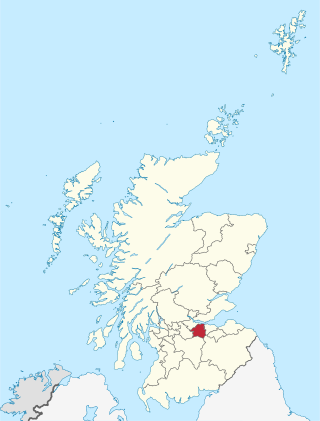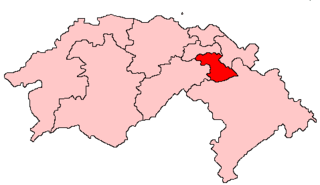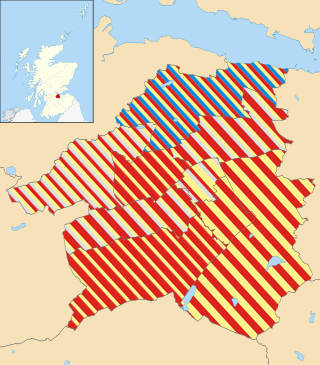
West Lothian is one of the 32 council areas of Scotland, and was one of its historic counties. The county was called Linlithgowshire until 1925. The historic county was bounded geographically by the Avon to the west and the Almond to the east. The modern council area occupies a larger area than the historic county. It was reshaped following local government reforms in 1975: some areas in the west were transferred to Falkirk; some areas in the east were transferred to Edinburgh; and some areas that had formerly been part of Midlothian were added to West Lothian.
The politics of Edinburgh are expressed in the deliberations and decisions of the City of Edinburgh Council, in elections to the council, the Scottish Parliament and the UK Parliament.

The Lothians was one of the eight electoral regions of the Scottish Parliament (Holyrood) from 1999 to 2011. Nine of the parliament's 73 first past the post constituencies were sub-divisions of the region and it elected seven of the 56 additional-member Members of the Scottish Parliament (MSPs). Thus it elected a total of 16 MSPs.

South of Scotland was one of the eight electoral regions of the Scottish Parliament when it was created in 1999. The region was replaced with South Scotland in 2011 following a review.

Edinburgh South was a constituency of the Scottish Parliament (Holyrood). It elected one Member of the Scottish Parliament (MSP) by the plurality method of election. Also, however, it was one of nine constituencies in the Lothians electoral region, which elected seven additional members, in addition to nine constituency MSPs, to produce a form of proportional representation for the region as a whole.

Edinburgh West was a constituency of the Scottish Parliament (Holyrood) from 1999 until 2011. It elected one Member of the Scottish Parliament (MSP) by the plurality method of election. It was also one of nine constituencies in the Lothians electoral region, which elected seven additional members, in addition to nine constituency MSPs, to produce a form of proportional representation for the region as a whole.

Edinburgh North and Leith was a constituency of the Scottish Parliament (Holyrood). It elected one Member of the Scottish Parliament (MSP) by the plurality method of election. Also, however, it was one of nine constituencies in the Lothians electoral region, which elects seven additional members, in addition to nine constituency MSPs, to produce a form of proportional representation for the region as a whole.

Livingston is a county constituency of the House of Commons of the Parliament of the United Kingdom, to which it returns one Member of Parliament (MP). Elections are held using the first-past-the-post voting system.

Linlithgow is a constituency of the Scottish Parliament (Holyrood) covering part of the council area of West Lothian. It elects one Member of the Scottish Parliament (MSP) by the plurality method of election. It is also one of nine constituencies in the Lothian electoral region, which elects seven additional members, in addition to the nine constituency MSPs, to produce a form of proportional representation for the region as a whole.

East Lothian is a constituency of the Scottish Parliament (Holyrood) covering most of the council area of East Lothian. It elects one Member of the Scottish Parliament (MSP) by the plurality method of election. It is also one of nine constituencies in the South Scotland electoral region, which elects seven additional members, in addition to the nine constituency MSPs, to produce a form of proportional representation for the region as a whole.

Edinburgh East and Musselburgh was a constituency of the Scottish Parliament (Holyrood). It elected one Member of the Scottish Parliament (MSP) by the plurality method of election. Also, however, it is one of nine constituencies in the Lothians electoral region, which elects seven additional members, in addition to nine constituency MSPs, to produce a form of proportional representation for the region as a whole.

Midlothian was a constituency of the Scottish Parliament (Holyrood). It elected one Member of the Scottish Parliament (MSP) by the plurality method of election. Also, however, it was one of nine constituencies in the Lothians electoral region, which elected seven additional members, in addition to nine constituency MSPs, to produce a form of proportional representation for the region as a whole.

East Lothian Council is one of the 32 local government councils in Scotland covering the East Lothian area. Since the last boundary changes in 2017, 22 councillors have been elected from 6 wards.

West Lothian Council is the local authority for West Lothian, one of the 32 council areas of Scotland.

Elections to West Lothian Council were held on 3 May 2007, the same day as the other Scottish local government elections and the Scottish Parliament general election. The election was the first to use nine new wards created as a result of the Local Governance (Scotland) Act 2004, each ward elects three or four councillors using the single transferable vote system form of proportional representation. The new wards replace 32 single-member wards which used the plurality system of election.

Almond Valley is a constituency of the Scottish Parliament (Holyrood) covering part of the council area of West Lothian. It elects one Member of the Scottish Parliament (MSP) by the plurality method of election. It is also one of nine constituencies in the Lothian electoral region, which elects seven additional members, in addition to the nine constituency MSPs, to produce a form of proportional representation for the region as a whole.

Edinburgh Western is a constituency of the Scottish Parliament (Holyrood) covering part of the City of Edinburgh council area. It elects one Member of the Scottish Parliament (MSP) by the plurality method of election. It is one of nine constituencies in the Lothian electoral region, which elects seven additional members, in addition to the nine constituency MSPs, to produce a form of proportional representation for the region as a whole.

Midlothian North and Musselburgh is a constituency of the Scottish Parliament (Holyrood) covering parts of the council areas of Midlothian and East Lothian. It elects one Member of the Scottish Parliament (MSP) by the plurality method of election. It is one of nine constituencies in the Lothian electoral region, which elects seven additional members, in addition to the nine constituency MSPs, to produce a form of proportional representation for the region as a whole.

The City of Edinburgh Council is the local government authority covering the City of Edinburgh council area. Almost half of the council area is the built-up area of Edinburgh, capital of Scotland. With a population of 514,990 in mid-2019, it is the second most populous local authority area in Scotland.

The 2022 West Lothian Council election took place on 5 May 2022. Elected positions in all 9 wards created as a result of the Local Governance (Scotland) Act 2004 were up for election, with each ward electing three or four Councillors using the single transferable vote (STV) system form of proportional representation, with 33 Councillors being elected in total.















